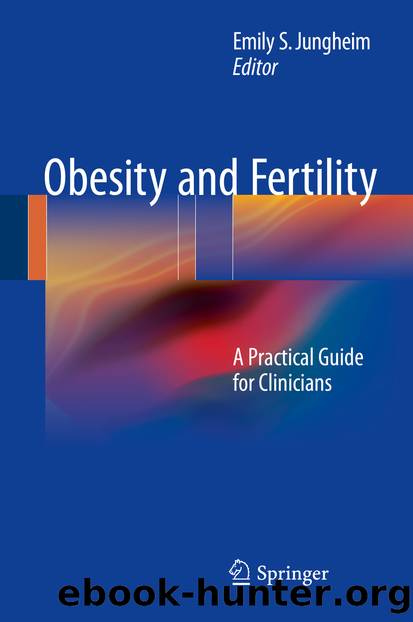Obesity and Fertility by Emily S. Jungheim

Author:Emily S. Jungheim
Language: eng
Format: epub
Publisher: Springer New York, New York, NY
Endometrial Receptivity Versus Poor Embryo Quality: Which Is Responsible for the Decreased Pregnancy Rates in Obese Women?
While data suggest that the implantation rate for obese women is poorer than normal-weight women, the majority of studies are unable to differentiate the impact of embryo quality from that of endometrial receptivity. Are implantation rates low because of poor embryo quality or because of a hostile intrauterine environment? This is currently a heavily debated topic and there are data available to support both possibilities.
An ideal study would eliminate one of the variables in question—for example, examining implantation and pregnancy rates in obese women who undergo IVF using oocytes from nonobese donors. In a study of 10,000 first IVF cycles using oocytes from healthy normal-weight donors, rates of implantation were significantly lower when recipient BMI increased beyond 25 kg/m2 (38.5 % in women with a BMI 25–29.9 kg/m2 versus 39.9 % in recipients with a BMI 20–24.9 kg/m2, p < 0.001), and dramatically so after recipient BMI increased beyond 30 kg/m2 (30.5 % p < 0.001) [39]. Clinical pregnancy rates were similarly diminished with increasing BMI (55.9 % in recipients with a BMI 20–24.9 kg/m2 compared to 54.3 % for a BMI 25–29.9 kg/m2, and 45.4 for women with a BMI ≥ 30, p < 0.001). Clinical miscarriage rate and ectopic pregnancy rates were similar for all BMI groups. In the setting of unchanged laboratory and embryo parameters, these data suggest that uterine receptivity may be compromised in obese women.
Conflicting results have been reported, however, by a large analysis of 33,000 cycles from the Society for Assisted Reproductive Technologies (SART) database, which found a significant inverse association between obesity and pregnancy rate with the use of autologous oocytes, but no difference with the use of donor oocytes [40]. These data suggest an adverse impact of obesity on oocyte quality rather than endometrial receptivity. This concept was further supported by a recent meta-analysis comparing the chance of pregnancy in obese versus normal-weight donor oocyte recipients that did not include the aforementioned retrospective study of 10,000 cycles and found no difference in implantation (RR 0.93 [95 % CI 0.80–1.07]) or clinical pregnancy rates (RR 0.98 [95 % CI 0.83–1.15]) in obese as compared to normal-weight donor oocyte recipients [41].
Download
This site does not store any files on its server. We only index and link to content provided by other sites. Please contact the content providers to delete copyright contents if any and email us, we'll remove relevant links or contents immediately.
Men In Love by Nancy Friday(5155)
Everything Happens for a Reason by Kate Bowler(4678)
The Immortal Life of Henrietta Lacks by Rebecca Skloot(4525)
Why We Sleep by Matthew Walker(4360)
The Sports Rules Book by Human Kinetics(4294)
Not a Diet Book by James Smith(3336)
The Emperor of All Maladies: A Biography of Cancer by Siddhartha Mukherjee(3064)
Sapiens and Homo Deus by Yuval Noah Harari(2987)
Day by Elie Wiesel(2719)
Angels in America by Tony Kushner(2596)
A Burst of Light by Audre Lorde(2546)
Endless Forms Most Beautiful by Sean B. Carroll(2431)
Hashimoto's Protocol by Izabella Wentz PharmD(2331)
Dirty Genes by Ben Lynch(2272)
Reservoir 13 by Jon McGregor(2242)
Wonder by R J Palacio(2139)
And the Band Played On by Randy Shilts(2129)
The Immune System Recovery Plan by Susan Blum(2027)
Stretching to Stay Young by Jessica Matthews(2001)
